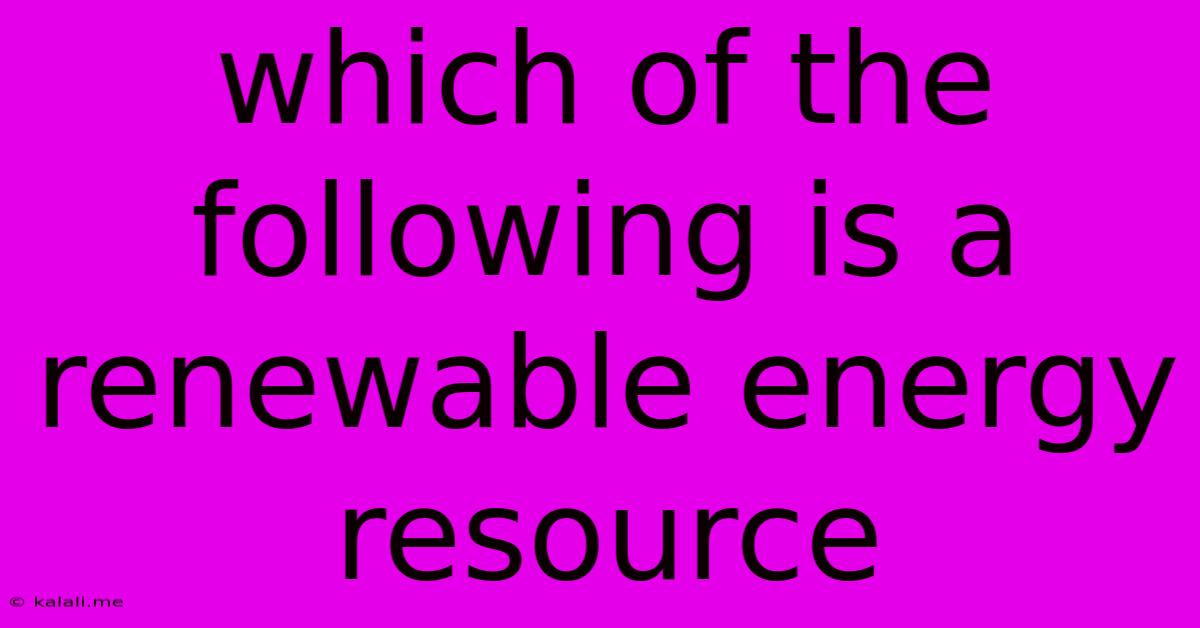Which Of The Following Is A Renewable Energy Resource
Kalali
May 10, 2025 · 3 min read

Table of Contents
Which of the Following is a Renewable Energy Resource? Understanding Sustainable Energy Sources
Renewable energy resources are those that naturally replenish themselves over a relatively short period, unlike finite fossil fuels like coal, oil, and natural gas. This makes them crucial for a sustainable future, minimizing our environmental impact and ensuring energy security. But with so many options, understanding which energy sources are truly renewable is key. This article will explore several energy sources and clarify which are considered renewable.
What are Renewable Energy Resources?
Renewable energy sources are characterized by their ability to be replenished naturally. This means they are not depleted by use and are constantly being regenerated by natural processes. The most common examples include solar, wind, hydro, geothermal, and biomass energy. These resources offer a cleaner and more sustainable alternative to traditional fossil fuels, reducing greenhouse gas emissions and combating climate change. Let's delve deeper into specific examples:
Examples of Renewable Energy Resources:
-
Solar Energy: Harnessing the sun's power through photovoltaic (PV) cells to generate electricity or using solar thermal technologies to heat water or buildings. This is arguably the most abundant renewable resource, with the sun constantly providing energy. Solar panel technology continues to improve, making it increasingly efficient and cost-effective.
-
Wind Energy: Utilizing wind turbines to convert the kinetic energy of wind into electricity. This is a clean and efficient source of energy, particularly prevalent in areas with consistent strong winds. Offshore wind farms are becoming increasingly popular due to higher and more consistent wind speeds.
-
Hydropower: Generating electricity from the movement of water, typically through dams and reservoirs. This is a well-established renewable energy source, but its environmental impact, particularly on aquatic ecosystems, needs careful consideration. Run-of-river hydropower, which minimizes the impact on water flow, is a more environmentally friendly option.
-
Geothermal Energy: Harnessing the heat from the Earth's interior. This can be used directly for heating and cooling, or to generate electricity in geothermal power plants. Geothermal energy is a reliable and consistent source of energy, particularly in volcanically active regions.
-
Biomass Energy: Using organic matter, such as wood, crops, or waste, to produce energy through combustion or conversion into biofuels. While biomass is technically renewable, sustainable practices are crucial to avoid deforestation and soil degradation. Careful management and responsible sourcing are vital to its long-term viability.
Energy Sources That Are Not Renewable:
It's equally important to understand what constitutes non-renewable energy resources. These are finite resources that take millions of years to form and are depleted with use. The primary examples include:
-
Fossil Fuels (Coal, Oil, and Natural Gas): These are formed from ancient organic matter and are responsible for a significant portion of global greenhouse gas emissions. Their finite nature and environmental impact necessitate the transition towards renewable energy sources.
-
Nuclear Energy: While nuclear power plants don't directly emit greenhouse gases, they rely on uranium, a finite resource, and produce radioactive waste requiring careful management for thousands of years.
Choosing the Right Renewable Energy Resource:
The best renewable energy resource for a given location depends on various factors, including geographical conditions, climate, energy demand, and available resources. A comprehensive energy assessment is crucial to determine the most suitable and sustainable option. For example, areas with high solar irradiance are ideal for solar power, while regions with consistent winds are suited for wind energy.
In conclusion, understanding the distinctions between renewable and non-renewable energy sources is paramount for building a sustainable energy future. Solar, wind, hydro, geothermal, and sustainably managed biomass are all examples of renewable energy resources that offer clean, sustainable, and replenishable energy alternatives. The transition to these sources is crucial for mitigating climate change and securing our energy independence.
Latest Posts
Latest Posts
-
Cuanto Son 10 Centimetros En Pulgadas
May 10, 2025
-
How Many Feet Are In 108 In
May 10, 2025
-
What Is 37 Celsius To Fahrenheit
May 10, 2025
-
What Percent Is 4 Of 7
May 10, 2025
-
10 Is 5 Of What Number
May 10, 2025
Related Post
Thank you for visiting our website which covers about Which Of The Following Is A Renewable Energy Resource . We hope the information provided has been useful to you. Feel free to contact us if you have any questions or need further assistance. See you next time and don't miss to bookmark.